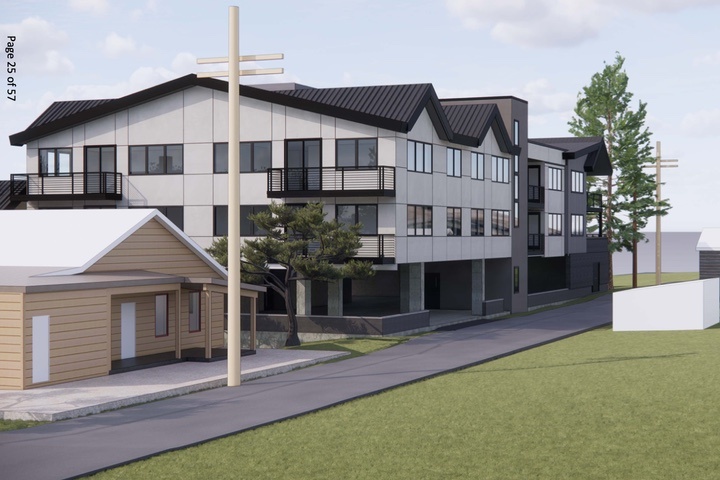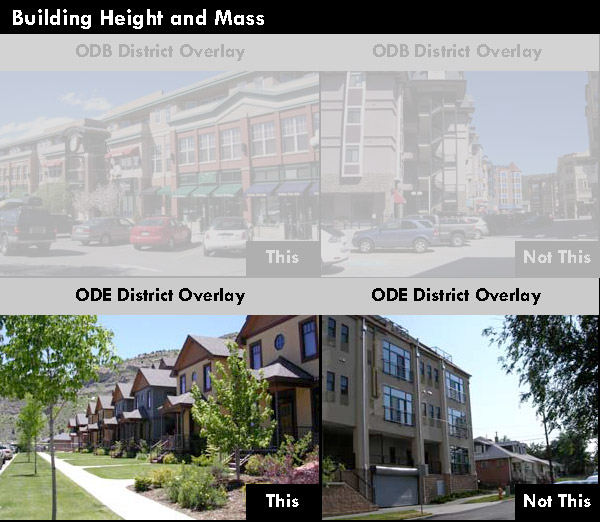Photo: Citizen volunteers discussing a municipal ‘Downtown Master Plan’ in 2006.
Big dreams can be wonderful. They can also lead to a big mess.
Sometimes a law or regulation, that seems perfectly clear to one set of citizens, is ‘interpreted’ to mean something very different by another set of citizens.
Sometimes not even photographs and illustrations can help sort through the disagreement.
Say, for example, the proposed building is within the ODE overlay — the ‘East Village’ regulatory district — and new development is required to be “compatible” with other buildings within the overlay district, in terms of land use and architectural design.
One of the main characteristics of architectural design is, of course, size. Height, and mass.
The Town’s Land Use and Development Code includes some illustrations related to the ODE district, such as this one, below — so that architects have some guidance concerning what the Town will or will not approve:
I have placed a gray overlay on the photos illustrating the types of building designs acceptable in the ODB district — the Downtown Business District, which is located to the west of the ODE. In the lower section of this illustration, we see the type of new development the Town expects to approve in the East Village, labeled as “This”.
An unacceptable architectural design is also shown, labeled as “Not This”. The building shown as “Not This” would not even be acceptable in the Downtown Business overlay district, which is much more lenient in terms of height and mass.
We might — if we were so inclined — compare the “This” and “Not This” photographs with the drawings of the mixed-use building proposed for 232 Pagosa Street. Here is the rear elevation.

People may disagree about what they are seeing with their eyes, but to me, the rear elevation of the proposed 232 building looks a lot more like “Not This” than like “This”.
The rest of the existing East Village, meanwhile, more closely resembles “This”.
When architect Brad Ash and property owner Martin Rose first proposed a massive three-story building on three vacant acres facing Pagosa Street (Highway 160) towards the east end of Pagosa’s downtown commercial district, the neighbors began researching the municipal Land Use and Development Code (LUDC), to determine if such a development was even legal.
A casual reading of the LUDC suggests the proposed development did not comply with the code, nor with the Downtown Master Plan adopted by the Town Council in 2007.
These two documents — the LUDC and the Downtown Master Plan — are different animals. The Downtown Master Plan is a collection of “community endorsed” suggestions, to help guide the creation of the LUDC. (In reality, only about two dozen people worked on the final draft of the Downtown Master Plan. Often, local planning documents are created by even fewer people.)
The LUDC, however, is a collection of codes. Laws. Rules that must be followed, by everyone.
Or so I was once led to believe.
I learned a bit about ‘interpreting’ laws when I served on the Town Planning Commission, and discovered that several of my fellow commissioners believed the LUDC was not, in fact, a set of laws that must be followed, but rather a collection of “suggestions.”
After I pointed out to my fellow commissioners a particular statement within the LUDC that seems to imply the existence of ‘hard and fast rules’ that cannot be violated…
1.4.2. COMPLIANCE REQUIRED
A. No building or structure shall be erected, converted, enlarged, reconstructed, or altered for use, nor shall any land, building, or structure be used or changed, except in accordance with all of the applicable regulations established by this Land Use Code… A permit or approval issued in violation of this Land Use Code is void.
… my fellow commissioners recommended that I be fired from the Planning Commission. I did in fact get removed from the Commission, in June 2020, and the Town Council subsequently modified the LUDC, giving themselves the power to bestow special development privileges on property owners, whenever the Planning Commission requests such special privileges. As I understand the revisions to the LUDC (made subsequent to my removal from the Commission) the LUDC has ceased to be a set of laws and is now essentially a collection of suggestions, as my fellow commissioners had indeed proposed in 2020.
From the revised LUDC:
1.2.1. WAIVERS AND AMENDMENTS
A. Following the recommendation of the Planning Commission, the Town Council may authorize waivers from the provisions of this Chapter. Waivers may be granted for the purpose of encouraging flexibility and variety in land development… Waivers may be granted if it is deemed by the Town Council to be in the public interest and does not impair the intent and purposes of this Chapter. The conditions of any waiver authorized shall be stated in writing by the Town Council with the justifications set forth…
Since LUDC requirements can now be waived by the Town Council — to encourage “flexibility and variety in land development” — we can no longer depend on the LUDC to protect existing property rights, which once seemed to include guarantees that massive, three-story buildings would be built only in appropriate locations, and not in residential neighborhoods.
That being said, I’m personally in favor of reducing — in many cases — the land use regulations imposed by our Town and County governments. I believe we are at a stage of our cultural and economic development, here in the U.S., where excessive government regulations are helping cause a serious housing crisis, nationally, as well as a serious energy crisis, nationally, and that it’s our poorest families who are suffering most from the excessive regulation.
Certainly, we need some level of regulation, to ensure we don’t overload our public infrastructure… our supply of drinking water, for instance, or our ability to treat wastewater.
But based on my research over the past 20 years, writing about development in Pagosa Springs, I’ve come to the conclusion that we need to double the number of dwelling units located within the town limits… because the areas outside the town limits, in the unincorporated county, present various roadblocks to attainable workforce housing.
Unfortunately, our current municipal LUDC has had the effect of stifling necessary housing within the downtown.
We also need the monthly cost of these these new homes and apartments to align with the low-wage jobs created by our tourism industry. Turns out, a development group is proposing to do something along those lines within the town limits, although the details are not completely clear.
The developers of the proposed downtown subdivision, currently known as Pagosa Views, presented ‘Phase One’ of their plan to the Town Planning Commission on January 23. Rather than approve the plat, however, the Commission continued the hearing to a later, undefined date…


